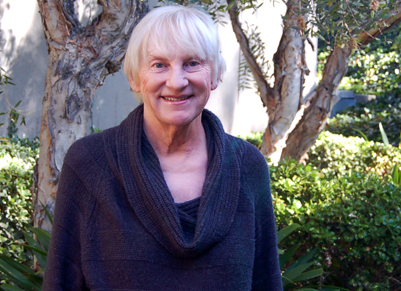
Janie MacHarg has been collaborating with staff members to provide student services at California State University, Dominguez Hills for more than four decades, serving in four different roles, including her current position as director of Student Health and Psychological Services (SHPS). She has been recognized with the 2012 Management Personnel Plan (MPP) Outstanding Collaboration Award. It was the first time that category of staff was recognized since the awards began in 2010.
“I was absolutely stunned when I got a call saying I had been nominated, much less that I was a finalist. I was very honored by that,” MacHarg said. “That meant a lot to me…that one of my own staff members nominated me.”
Irina Gaal, M.D., chief of medical services in the Student Health Center, who nominated MacHarg for the award, said, “There is no sense of distance with Janie, since she treats everyone with equal respect whether she’s talking with a student assistant, clerical person, medical staffer or faculty member.”
Gaal added, “Janie has weathered many storms …all with one fundamental principle: an open door policy such that any and every staff member has felt completely comfortable coming to her office to discuss an issue.”
Respecting different professional cultures and the distinction of each staff member’s role are key to creating an environment of collaboration, noted MacHarg, who oversees 19 full-time and six part-time employees.
“The front office person is as critical to our operations as the chief of medical services,” she asserted.
Before arriving at CSU Dominguez Hills, MacHarg knew she wanted to help people, although she didn’t know in what field. She had a master’s degree in counseling and college student personnel services from Columbia University in New York, and a bachelor’s in psychology from Scripps College in Claremont, so her options were open.
“At that time I was leaning toward doing something in student affairs or student services in a college. That’s why I applied for the career counseling at CSU Dominguez Hills,” she said.
That was in 1969, and after four years as a career counselor she became the director of Career Planning and Placement then housed in the Small College Complex. But after two years in that role, and working in close proximity of what was then called personal counseling, she had an epiphany.

“Interacting on a daily basis with the director of counseling and the one counselor that was there, I could tell that I was more interested in what they were doing than what I was doing. That’s what motivated me to go back for my doctorate in psychology,” said MacHarg, who earned her Ph.D. in psychology from the University of Southern California.
“I had always been interested in what motivates people to do things and how they cope with problems,” she recalled.
Her ability to analyze how people approach things has served her well over that past 20 years as more and more universities nationwide began merging their psychological and medical centers. In 1977, with MacHarg as the director, CSU Dominguez Hills became the first–she estimates by at least a decade–among all the 23 CSU campuses to merge the two health service areas. And today about half of the CSU campuses have health centers that treat both psychological and physical health needs of students. CSU Dominguez Hills, along with Cal Poly San Luis Obispo, are the only two CSUs to have a psychologist serve as a director of an integrated care center. Others are led by a physician or an administrator with a public health background or, in a few cases, a student affairs administrator who has neither a health or mental health background.
“The most rewarding thing is knowing what kind of critical health care we’re giving to students. And I feel the same way about the health center side,” MacHarg said. “The medical staff here does some pretty sophisticated things. Some students who are very high users of our services are getting hundreds, if not thousands of dollars, worth of service equivalent of their $75 semester mandatory health fee.”
MacHarg said there are some challenges that come with progress and growth. In addition to keeping up with legal changes in the psychology and medical fields, the destigmatization of psychotherapy, the increased foot traffic that came with the addition of Welch Hall in 2002, and increased outreach efforts, the Student Health Center has had to service considerably more students each year. However, through surveys, students report that the health care they receive from the center is important to their academic success, so the center seems to be fulfilling its purpose.
“Janie does so many behind-the-scenes leadership activities seamlessly, while fully participating not only in the day-to-day operations of SHPS, but gradually growing our business to better serve students through improving and expanding the offerings of our unit,” Gaal said.
MacHarg, who has been directing the Student Health Center since 1977, praised her staff for working together to provide a high level of care. A sense of camaraderie that was prevalent during the university’s early years is still present today. Seeing considerable changes in infrastructure and technology, and having worked under every president in the university’s history, MacHarg said CSU Dominguez Hills retains a sense of family.
“There are a lot of people in this unit who have been here for a really long time,” MacHarg said. “It’s been a remarkably stable staff. We know the history of each other’s children, from the time they were born and tiny, through deaths, births, weddings, and through many, many things. There are some very close relationships here that I value.”
The Manhattan Beach resident plans to keep working as long as she still feels challenged and finds her job fulfilling, and since her husband, Rob Rutman, a psychologist in private practice, has no immediate plans to retire, neither does she.
“I really like my job,” she said. “And I can travel during vacation.”